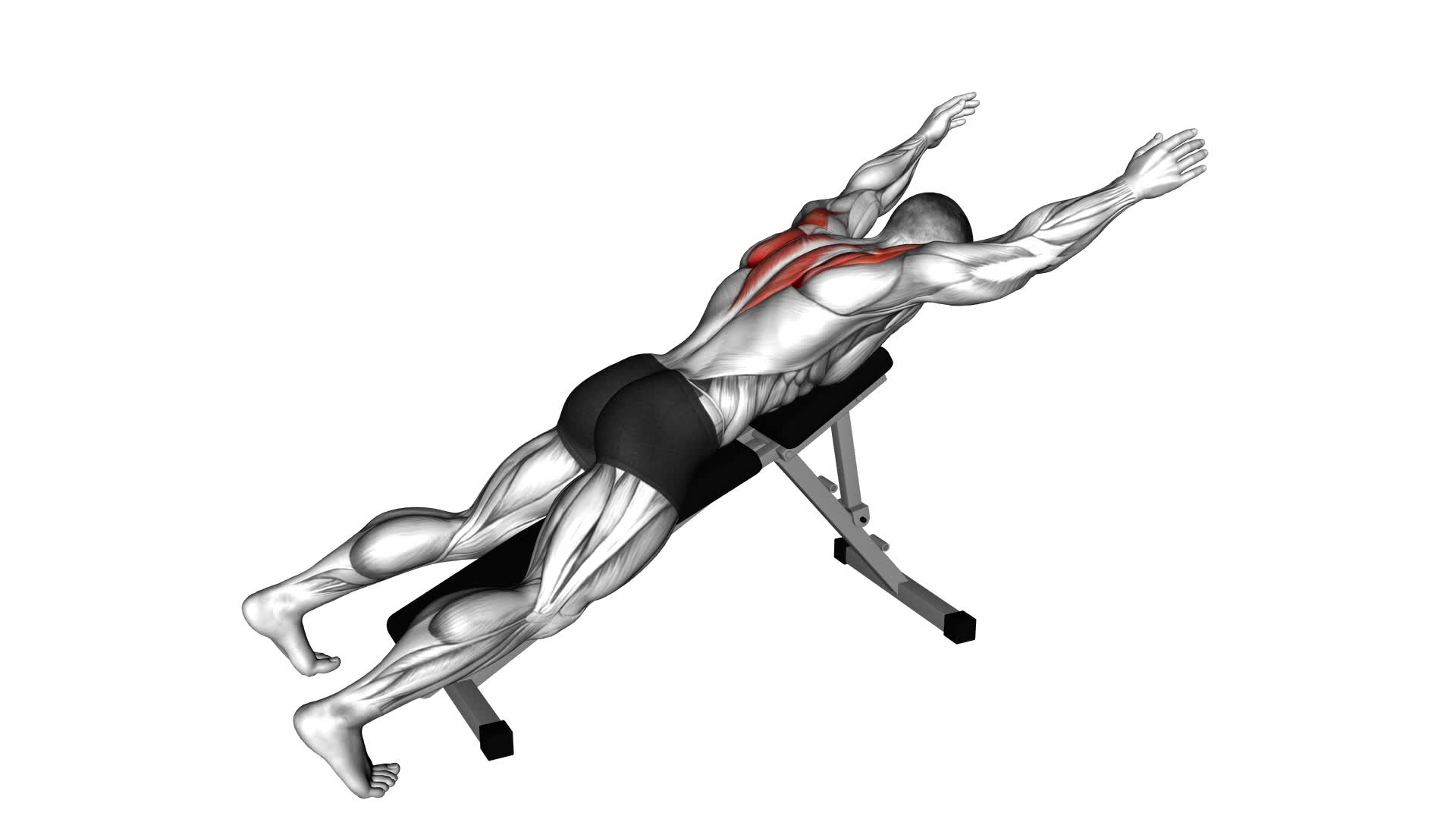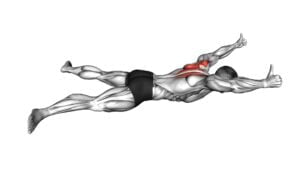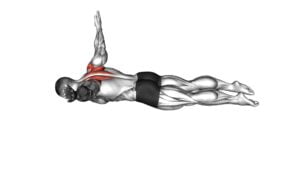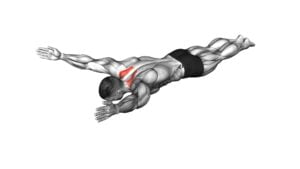Prone Y Raise (male) – Video Exercise Guide & Tips

Are you looking to strengthen your upper body and improve your posture? The Prone Y Raise exercise is exactly what you need!
Watch This Exercise Video
In this video exercise guide, we'll show you the proper form and technique for performing this move. Whether you're a beginner or an advanced fitness enthusiast, we've got modifications for every fitness level.
Get ready to incorporate the Prone Y Raise into your workout routine and reap the benefits of a stronger, more confident you. Let's get started!
Key Takeaways
- Prone Y Raise targets multiple muscles in the upper body and is highly effective for improving posture and shoulder stability.
- It engages the muscles in the upper back, shoulders, and arms, strengthening and stabilizing these areas and reducing the risk of shoulder injuries.
- The exercise targets the rotator cuff muscles, which are essential for maintaining shoulder stability.
- Proper form and technique, such as keeping the core engaged and avoiding excessive arching of the lower back, are important for maximizing the benefits of Prone Y Raise.
Benefits of Prone Y Raise
One major benefit of the Prone Y Raise exercise is that it targets multiple muscles in your upper body. This exercise is highly effective for improving your posture and shoulder stability. By engaging the muscles in your upper back, shoulders, and arms, the Prone Y Raise helps strengthen and stabilize these areas, leading to improved posture and reduced risk of shoulder injuries.
When you perform the Prone Y Raise, you activate your rhomboids, trapezius, and posterior deltoids. These muscles work together to pull your shoulders back and downward, aligning them with your spine and promoting a more upright posture. Additionally, the exercise targets the rotator cuff muscles, which are essential for maintaining shoulder stability.
By incorporating the Prone Y Raise into your workout routine, you can develop better posture and shoulder stability, which can have a positive impact on your overall physical health and performance. It's an excellent exercise for individuals who spend long hours sitting or working at a desk, as it helps counteract the forward shoulder position commonly associated with sedentary lifestyles.
In the next section, we'll discuss the proper form and technique to maximize the benefits of the Prone Y Raise exercise.
Proper Form and Technique
To perform the Prone Y Raise exercise correctly, follow these steps:
- Extend your arms straight out in front of you while lying face down.
- Keep your head in a neutral position, looking down towards the floor.
- Engage your core muscles to stabilize your body throughout the movement.
- Slowly lift your arms and upper chest off the ground, squeezing your shoulder blades together.
- Imagine forming a Y shape with your body as you raise your arms.
- Maintain control and avoid using momentum to swing your arms up.
- Focus on using your back muscles to lift and lower your arms.
- Keep your elbows slightly bent throughout the exercise to reduce strain on your joints.
Remember, form is key to getting the most out of the Prone Y Raise. By practicing proper technique, you'll engage the targeted muscles effectively and reduce the risk of injury.
Now, let's move on to the next section to learn about the equipment needed for the Prone Y Raise.
Equipment Needed for Prone Y Raise
To perform the Prone Y Raise exercise correctly, you'll need minimal equipment. Here are the essential items you'll need:
- Exercise Mat: A comfortable and supportive exercise mat will provide cushioning for your body during the Prone Y Raise. It will also help prevent any discomfort or strain on your joints.
- Dumbbells: You'll need a pair of dumbbells to add resistance to the exercise. Start with lighter weights and gradually increase as you get stronger. This will help target your back muscles effectively.
- Bench or Swiss Ball (optional): While not necessary, a bench or Swiss ball can be used to elevate your chest slightly during the exercise. This can increase the range of motion and intensity of the Prone Y Raise.
- Resistance Bands (optional): If you don't have dumbbells, resistance bands can be a suitable alternative. They provide adjustable resistance and can be easily packed for travel or home workouts.
Common Mistakes to Avoid
To avoid common mistakes during the Prone Y Raise exercise, it's important to maintain proper form and technique.
- One common mistake is lifting the upper body too high off the ground. Remember that the goal of this exercise is to engage and strengthen the muscles in your upper back and shoulders, not to lift your entire body off the ground.
- Another mistake is using momentum instead of controlled movements. It's crucial to perform the exercise slowly and with control to effectively target the muscles.
- Additionally, avoid shrugging your shoulders during the movement, as this can put unnecessary strain on your neck and upper traps. Instead, focus on keeping your shoulders relaxed and down.
- Lastly, make sure to keep your core engaged throughout the exercise. This will help stabilize your body and prevent excessive arching of the lower back.
Modifications for Different Fitness Levels
Now let's explore how you can modify the Prone Y Raise exercise based on your fitness level. Whether you're a beginner or an advanced fitness enthusiast, there are modifications available to help you customize the exercise to your needs. Here are some modifications you can try:
Modifications for beginners:
- Start with lighter weights or no weights at all.
- Reduce the range of motion to avoid straining your muscles.
- Perform the exercise on an incline bench to decrease the difficulty.
- Focus on proper form and technique before increasing intensity.
Advanced modifications:
- Increase the weight you use for the exercise.
- Extend the range of motion to challenge your muscles further.
- Perform the exercise on a stability ball to engage your core muscles.
- Incorporate other variations of the Prone Y Raise, such as the Prone T Raise or Prone W Raise, to target different areas of your back and shoulders.
Tips for Incorporating Prone Y Raise Into Your Workout Routine
To effectively incorporate the Prone Y Raise into your workout routine, it's important to focus on proper form techniques.
Keep your core engaged and maintain a neutral spine throughout the exercise.
Additionally, remember to squeeze your shoulder blades together as you lift your arms, maximizing the benefits of this exercise for your upper back and shoulders.
Proper Form Techniques
When incorporating the Prone Y Raise into your workout routine, it's important that you focus on proper form techniques to maximize the effectiveness of the exercise. Here are some tips to help you maintain proper form and reap the benefits of this exercise:
- Lie face down on a mat with your arms extended overhead, forming a Y shape with your body.
- Engage your core and squeeze your shoulder blades together as you lift your arms off the ground.
- Keep your neck neutral and avoid straining it.
- Control the movement and avoid using momentum.
By following these proper form techniques, you can ensure that you target the muscles in your shoulders, upper back, and rear delts effectively.
This exercise can help improve posture, strengthen the back, and enhance shoulder stability.
Benefits of Exercise
To maximize the benefits of incorporating the Prone Y Raise into your workout routine, follow these tips and techniques.
Regular exercise offers numerous benefits for your overall health and well-being. It's important to engage in physical activity to maintain a healthy weight, improve cardiovascular health, and strengthen your muscles and bones.
By adding the Prone Y Raise to your fitness regimen, you can further enhance these benefits. This exercise targets your shoulders, upper back, and posterior deltoids, helping to improve posture and upper body strength. Additionally, the Prone Y Raise can enhance shoulder stability and flexibility, reducing the risk of injury during other exercises or daily activities.
Remember to start with a weight that challenges you but allows for proper form, gradually increasing the load as you progress.
Incorporating the Prone Y Raise into your workout routine can contribute to the overall benefits of regular exercise and the importance of physical activity in maintaining a healthy lifestyle.
Frequently Asked Questions
How Many Sets and Reps Should I Do for the Prone Y Raise Exercise?
To get the most out of the prone Y raise exercise, it's important to know how many sets and reps to do. By incorporating this exercise into your routine, you can strengthen your upper back and shoulders, improve posture, and enhance shoulder stability.
However, doing too many sets or reps can lead to fatigue and potential injury. It's recommended to start with 2-3 sets of 10-12 reps and gradually increase as you get stronger.
Be sure to avoid common mistakes like using momentum or lifting too high.
Can I Do the Prone Y Raise Exercise With Dumbbells Instead of Using My Body Weight?
Yes, you can definitely do the prone Y raise exercise with dumbbells instead of using your body weight. Using weights in the prone Y raise can provide additional resistance and help increase the intensity of the exercise.
This can lead to improved muscle strength and definition in your upper back, shoulders, and arms. Just make sure to choose an appropriate weight that challenges you without compromising your form.
Is the Prone Y Raise Exercise Suitable for People With Shoulder Injuries?
The prone Y raise exercise can be beneficial for people with shoulder injuries, as long as it's done correctly and under the guidance of a professional.
It helps strengthen the muscles in the upper back and shoulders, which can aid in rehabilitation and prevent further injuries.
However, it's important to start with light weights or no weights at all, gradually increasing the intensity as your shoulder heals.
Always consult with a healthcare provider before attempting any exercise with an injury.
Should I Perform the Prone Y Raise Exercise at the Beginning or End of My Workout Routine?
When is the best time to perform the prone Y raise exercise in your workout routine? Should you use dumbbells instead of body weight?
It's important to consider the purpose of the exercise and your overall fitness goals. The prone Y raise exercise primarily targets the muscles of your upper back and shoulders. If you want to prioritize these muscles, you can perform the exercise at the beginning of your workout routine. Using dumbbells can increase the intensity and challenge your muscles even more.
How Long Should I Hold the Extended Position During the Prone Y Raise Exercise?
To maximize the benefits of the prone Y raise exercise for upper body strength, it's important to hold the extended position for a few seconds. This helps to engage and work the muscles in your shoulders, upper back, and rear delts.
The duration of the hold can vary depending on your fitness level and goals, but aim for at least 2-3 seconds.
Remember, there are variations of the prone Y raise exercise for targeting different muscle groups, so feel free to explore those as well.
Keep up the good work!
Conclusion
Incorporating prone Y raises into your workout routine can offer numerous benefits, such as strengthening your upper back and shoulder muscles. By following proper form and technique and avoiding common mistakes, you can maximize the effectiveness of this exercise.
Whether you're a beginner or advanced fitness enthusiast, there are modifications available to suit your fitness level. Remember to consult with a professional trainer if you have any concerns or questions.
Start incorporating prone Y raises into your workouts and enjoy the results!

Author
Years ago, the spark of my life’s passion ignited in my mind the moment I stepped into the local gym for the first time. The inaugural bead of perspiration, the initial endeavor, the very first surge of endorphins, and a sense of pride that washed over me post-workout marked the beginning of my deep-seated interest in strength sports, fitness, and sports nutrition. This very curiosity blossomed rapidly into a profound fascination, propelling me to earn a Master’s degree in Physical Education from the Academy of Physical Education in Krakow, followed by a Sports Manager diploma from the Jagiellonian University. My journey of growth led me to gain more specialized qualifications, such as being a certified personal trainer with a focus on sports dietetics, a lifeguard, and an instructor for wellness and corrective gymnastics. Theoretical knowledge paired seamlessly with practical experience, reinforcing my belief that the transformation of individuals under my guidance was also a reflection of my personal growth. This belief holds true even today. Each day, I strive to push the boundaries and explore new realms. These realms gently elevate me to greater heights. The unique combination of passion for my field and the continuous quest for growth fuels my drive to break new ground.







